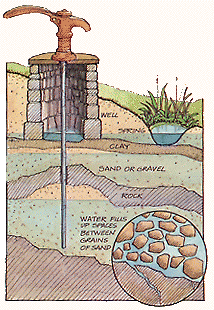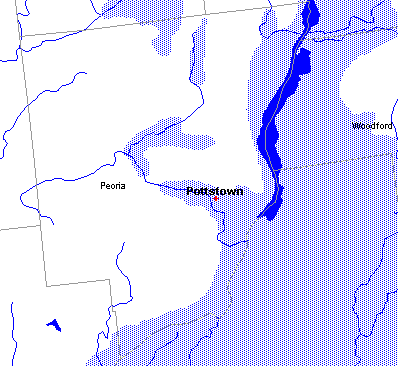One of the big arguments against an expanded toxic waste landfill is its location. It’s positioned over the Sankoty (sometimes written “San Koty”) aquifer. If you’re like me, you probably don’t remember a whole lot of that geology stuff from grade school or high school and you’re thinking to yourself, “what the heck is an aquifer?” Here’s what I’ve found out.
Simply stated, an aquifer is a water-bearing layer of earth. In fact, the word “aquifer” comes from Latin: aqui- which means “water,” and -fer (from ferre) which means “to bear.” The New Oxford American Dictionary defines “aquifer” as “a body of permeable rock that can contain or transmit groundwater.”
Beneath our feet us here in Peoria, there is a layer of sand and gravel that is porous and saturated with fresh water. It’s about 100 feet thick and is, thus, an abundant source of water used for both irrigation and drinking water in the region. I couldn’t find much information on the name “Sankoty,” except that it’s apparently named after the water well field on the northeast side of Peoria (source: Illinois State Water Survey). Illinois American Water Company uses three well sites to draw from the Sankoty aquifer, which accounts for 60% of our tap water.
 The picture to the left (from the Gulf of Maine Aquarium website) shows a good cross-section of the different layers of earth and how a simple well is used to access the water in an aquifer. They describe how an aquifer works like this:
The picture to the left (from the Gulf of Maine Aquarium website) shows a good cross-section of the different layers of earth and how a simple well is used to access the water in an aquifer. They describe how an aquifer works like this:
[P]recipitation (both rain and snow) runs into lakes, rivers, ocean, or into underground storage areas called aquifers. Aquifers are underground reservoirs. The water that reaches these chambers is usually much cleaner than the water of reservoirs at the earth’s surface. Almost no bacteria live in aquifers. Many pollutants are filtered out as the water passes through the soil on its way to the aquifer.
Clearly, this is an important natural resource for our region and one that we don’t want to see contaminated. Naturally, the people at PDC are professionals and they are doing everything they can to keep the aquifer from being contaminated. But even they would agree that there is a risk of contamination, even though they would argue that the risk is very low.
Let’s take a look at where exactly this Sankoty aquifer lies. Since it’s beneath the surface, it’s hard to find a map of it. However, I finally discovered one on the National Atlas of the United States website:

The dark blue lines are above-ground bodies of water; the gray lines are county borders; and the shaded blue area is the Sankoty Aquifer that lies below the surface. I’ve notated Pottstown on the map so you can see exactly where the toxic waste dump is located in relation to the aquifer.
Note that the aquifer does not underlie all, or even most, of Peoria County. Thus, it’s conceivable that another site could be found in the county for the dump that wouldn’t risk our groundwater at all, rather than expanding in its current site. Ideally, the current toxic waste could be relocated away from the aquifer as well, although I suppose that’s not financially feasible.
The more I study this issue, the more I’m convinced the county should deny the landfill expansion. I just can’t see any benefit to putting our groundwater at further risk, however low PDC promises us that risk would be. I can’t think of a better example of an issue on which it would be better to err on the side of caution.
